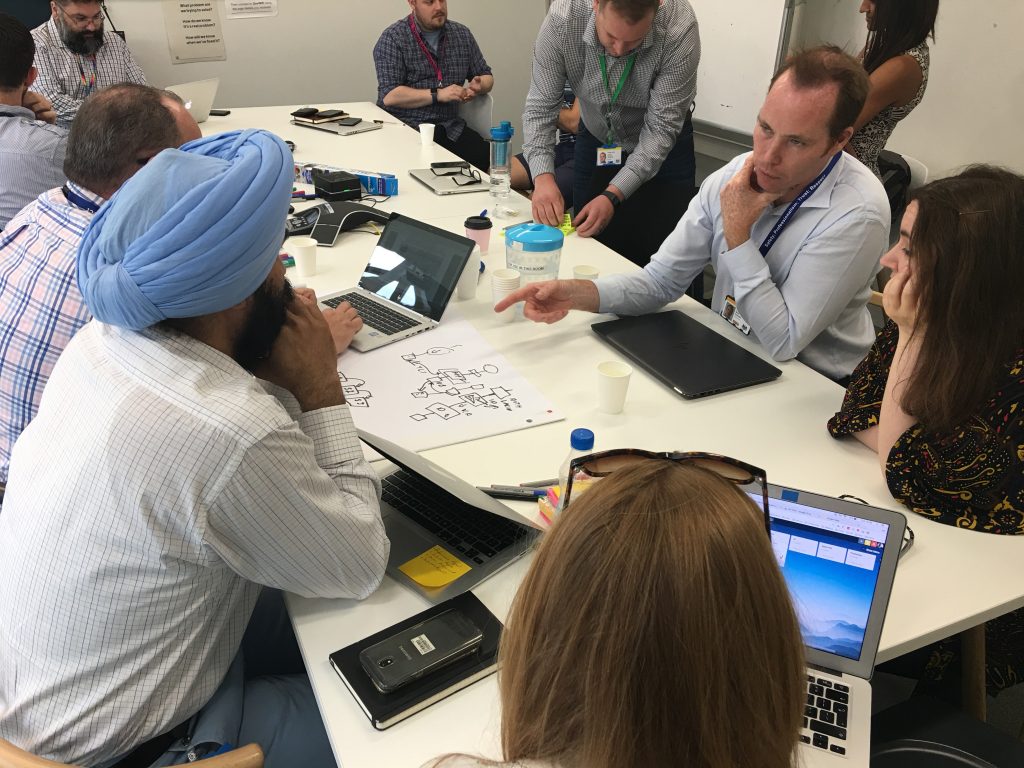
We held our first Consulting Technical Architects (CTA) drop-in at the GDS offices in Whitechapel at the start August. The half-day session was attended by technologists from a range of government departments and we plan to run this drop-in clinic once a month.
Our session ran from 12pm to 4pm. Technology practitioners and strategists discussed technology challenges they were facing, got advice from CTAs on how to deal with these challenges and learnt how other departments are tackling similar issues.
Talking about the cloud strategies
One of the biggest challenges facing departments is moving away from legacy technology to the cloud.
We started with a presentation showing the different approaches departments have taken since the introduction of the Cloud First policy. We gave an overview of how HMRC, GDS and the Home Office are implementing their cloud strategies.
1. HMRC’s Multi-Channel Digital Tax Platform
HMRC has built connections between its backend on-premise systems and its front-end services, many of which it now hosts in the cloud. Building an award-winning Multi-Channel Digital Tax Platform (MDTP) has allowed HMRC to use its existing, heritage systems in combination with the cloud.
The MDTP has allowed HMRC to move from 2 big disruptive IT releases a year to 50 releases a week with little or no disruption for their users. MDTP hosts 130 digital services and an API platform. In the last year, MDTP handled 150 million customer journeys and 150 million external API calls.
2. The GDS GOV.UK Platform as a Service
GDS developed GOV.UK Platform as a Service using the Cloud Foundry open source cloud application platform. This approach means GDS can essentially create a private cloud with the scale and cost benefits of the public cloud. Now, departments that do not have access to infrastructure specialists can still deploy applications to the cloud.
3. The Home Office Application Container Platform
The Home Office has built a Kubernetes-based delivery framework called the Application Container Platform (ACP). The ACP enforces a whole range of good practice development standards. For example, no resource changes can be made manually and must be made via code.
The ACP also includes all the design patterns needed to build a continuous development pipeline. ACP is also a great example of a team embracing the spirit of point 3 of the Technology Code of Practice - they use open source technologies, publish their codebase in the open, and have contributed back into some of the open source technologies they've used.
Topics participants discussed at our drop-in
During the breakout sessions CTA and attendees split into groups to discuss specific areas they wanted advice on. We talked about a variety of areas including:
- using APIs
- building services
- developing machine learning
- protecting data in the cloud
- opportunities for cross-government collaboration
- using management interfaces
- uploading content securely using cloud services
We put attendees in touch with other government colleagues who are working on similar issues. For example, the Ministry of Defence is looking at ways to protect data in the cloud and we know the Home Office has already done a lot of work in conjunction with the National Cyber Security Centre in this area. There is scope for this to be reused and we will put the 2 departments in touch.
Join us at the next event
Following the success of the first session, we’ll be running our drop in sessions once a month. This will help us to increase collaboration and knowledge sharing across government so we can solve technical challenges quickly and efficiently.
Our next event focuses on agile architecture and is scheduled to take place on 18 September at The Whitechapel Building. You can sign up on Eventbrite or email CTA-Mailbox@digital.cabinet-office.gov.uk.
Stay up to date with all the latest posts by signing up to alerts from Government Technology blog and follow Lee on Twitter.
